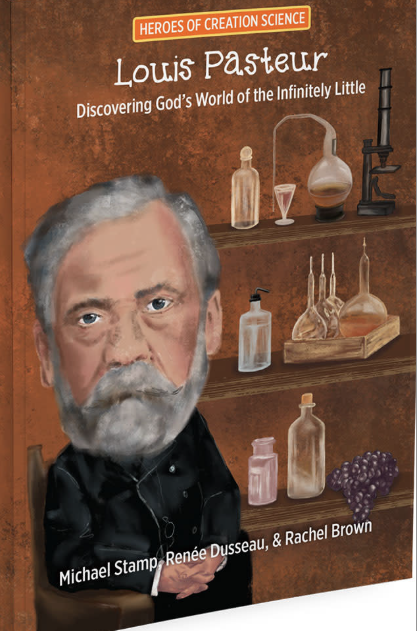While we may be aware of wonderful living creatures, we seldom reflect on the blessings of the material world. But the apostle Paul, way back in New Testament times in Lystra, assured his pagan audience that God provides favourable natural conditions to draw attention to himself. While God uses material blessings to draw attention to himself, some people wonder whether evolution can be included under the umbrella of God’s providential design. Since evolution is by definition a process that involves only matter and energy, then the evolutionary process can never involve foresight or design which are non-material. When we look at life however, we see features which demonstrate intelligent purpose and planning, thereby pointing to the work of God.
To start our study of life, let us consider a basic process that occurs in every single cell. This is DNA transcription (the copying of DNA into RNA for the manufacturing of proteins needed to keep the cell functioning.) A Japanese laboratory has produced a video clip that illustrates the complexity of the process. The proteins are drawn like angular machines, but you get the idea of how the system works. The subtitle is “From Genomic Information to Protein Synthesis.” See: https://www.youtube.com/watch?v=J3HVVi2k2No
This reflection on the complexity of simply copying DNA leads to the question: what is DNA and why is it so important for life? It so happens that DNA is like computer code (which carries information). Whereas computer code is binary (2 options of + or -, arranged in groupings of 8 choices), so also DNA has options (ATCG). These are arranged in groupings of three (each triplet of which calls for 1 of 20 amino acids). Since there are only 20 amino acids which are useful for life, and 64 ways to arrange 4 letters, some amino acids have several identifying codes.
Most component parts of our cells, including such things as molecular machines, are made of proteins. The smallest possible proteins are about 150 amino acids long. This is because the string of amino acids must fold up into the kind of precise shapes seen in the Japanese video. It is electrical attraction between amino acids that lead to a precise folding process. Not surprisingly, the order of amino acids needs to be very precise. The chances of suitable amino acids lining up correctly by chance are so small as to be impossible. For example, to obtain four correct amino acids in a row, the chances are 1/20 x 1/20 x 1/20 x 1/20 equals one chance in 160,000. And so it goes as we try to produce a 150 amino acid protein or larger by chance. And that is just the start, we need many proteins for life.
Despite its fancy nature, we are assured by many scientists that that DNA sequencing (figuring out the order of the letters) has confirmed the reality of evolution. One such scientist is Dr. Francis Collins, Director of the National Institutes of Health in the United States. In 2007 he published a book entitled The Language of God by which he meant that God communicates the truth of evolution to us through the nature of DNA coding. The book was an instant best seller and convinced many to support the concept of evolution.
One of the main arguments concerning DNA sequences is that they reflect lines of descent from simpler ancestors. The idea is that an initial order of DNA letters in a simple ancestral creature, becomes more and more modified as the descendants themselves are separated in time from the ancestor and in appearance from other contemporary creatures with different characteristics. The evolutionists assume that descent from a common ancestor has indeed occurred and so they interpret their observations to fit this idea. The starting assumption can alternatively be false and the conclusions likewise can be false, but they do not consider that possibility. Thus Dr. Collins and colleagues expect to see overall similarities in the coding for common features in organisms (like polymerase in DNA transcription). In addition, they expect to see increasingly different coding as the creatures exhibit greater differences from each other in body plans. What biologists do not expect to see is a totally different DNA order for similar appearing features. Obviously, a creature with one set of component parts did not develop into a creature with a completely different set of component parts.
When we see a common blue print for a structure in different creatures but made up of entirely different component parts, many scientists declare that this is an example of “convergence.” The definition of convergence is the appearance of a special feature in diverse organisms but no hint that change over time from a common ancestor might have been involved. Evolution cannot explain such “just because” features of life. Nature is full of examples of “convergence.”
One of the most famous cases of this phenomenon involves the diverse creatures which possess a camera eye. The essential features of the camera eye include a transparent lens and a layer of receptor cells upon which the lens focuses light. There are no similarities in body plan, and life style between the creatures which are blessed with a camera eye. Except for animals with backbones, the other creatures with such a feature constitute only one example out of a sea of similar creatures with no such benefit. See www.create.ab.ca/eye-deal-example-of-design
Besides such obvious physical structures however, we can see convergence in the information carried in the DNA. One of the most exciting recent developments in cell biology is CRISPR firewalls in many bacteria. This acronym stands for “clustered regularly interspaced short palindromic repeats.” This system (discovered less than 10 years ago) uses short copies of potentially hostile invading code (ferried around the cell by CRISPR code) to identify incoming virus DNA which would, if left alone, take over the controls of the bacterial cell and turn it into a virus-manufacturing factory.
Once a piece of hostile code has been identified by the CRISPR, an associated set of proteins moves in to destroy the incoming malware and save the cell. Scientists call these “destroyer” proteins “CRISPR associated systems” or Cas for short. There are various Cas systems which are given different numbers to identify them. See www.create.ab.ca/natural-firewalls-in-bacteria
An article in Nature (19 January 2017 vol. 541 p. 280-282) declared that “Researchers have officially recognized 6 different types of CRISPR system, with 19 subtypes. And we only know how a fraction of them works.” (p.282) The convergence among these Cas systems was exemplified by a recently discovered Cas system which displays “complete sequence dissimilarity to other CRISPR proteins.” (Nature February 14/19 vol 566 p. 221) Thus the 18 authors (last author Dr. Jennifer Doudna) conclude “These data demonstrate how CasX activity arose through convergent evolution …” (p. 218) What they are saying is that no known evolutionary mechanism exists to account for how these new proteins came about.
A further interesting example of chemical convergence is the odour receptors on insect antennae. See www.create.ab.ca/insect-talents-are-special It so happens that the fancy shape of insect odour receptors look similar to odour receptors of other creatures such as ourselves, but the make-up of these proteins is unlike any other known protein family. Indeed the insect receptors exhibit “unique repertoires” of chemical composition. (Nature August 23, 2018 vol. 560 p. 447)
So where do unique proteins coded by unfamiliar DNA sequences come from? A news feature in Nature (17 October 2019 vol. 514 p. 314-316) considered this question. The author reported that “Scientists long assumed that new genes appear when evolution tinkers with old ones.” ( p. 314) But of course that explanation does not work anymore. Thus after much reflection, he concludes that “Although de novo [brand new] genes remain enigmatic [mysterious], their existence makes one thing clear: evolution can readily make something from nothing.” (p. 316) Now isn’t that interesting!! The journal Nature has published an article which attributes miraculous power to evolution but only God has such power.
These examples and many more reveal God who is personal, an awesome Creator who makes choices for beauty, for purpose and planning and amazing complexity. So what response does the testimony of nature demand? The apostle Paul had the answer to that too. He told the pagan Greeks on Mars Hill that “He [the God who made the world and everything in it] gives to all mankind life and breath and everything …. That they should seek God and perhaps feel their way toward and find him.” (Acts 17: 27 +28) We could discuss any aspect of nature, but the answer will always be the same as that of the apostle Paul in Athens.
Margaret Helder
January 2020
Subscribe to Dialogue






